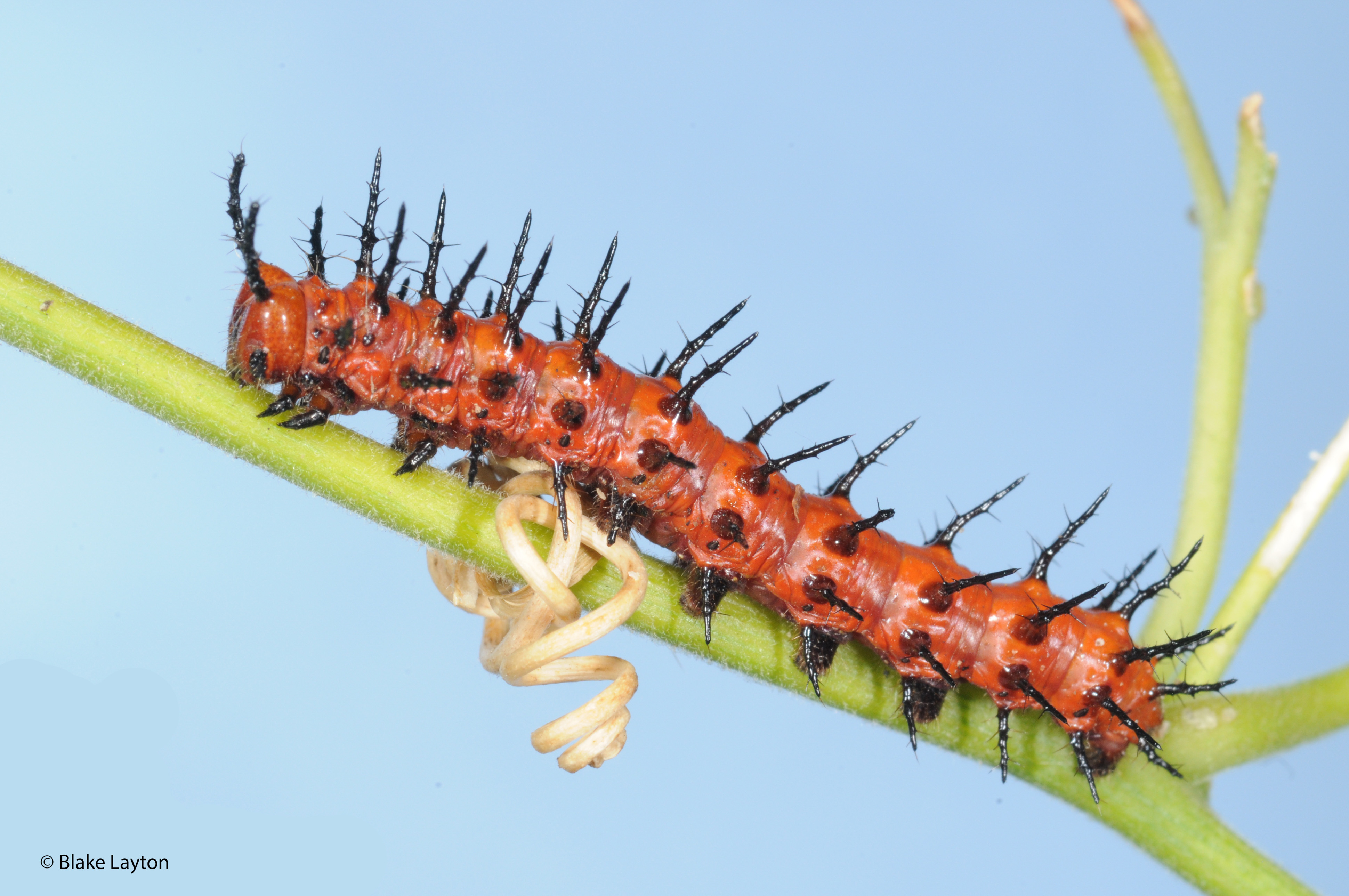Gulf Fritillary Vol. 9, No. 27
Related News
October 1, 2013
September 10, 2013
June 24, 2013
June 20, 2013
 “These spiny orange caterpillars ate all the leaves off the maypop vines that were growing on the fence at the edge of the yard. What are these things, and can they sting?”
“These spiny orange caterpillars ate all the leaves off the maypop vines that were growing on the fence at the edge of the yard. What are these things, and can they sting?”
Gulf fritillary caterpillars are passionflower specialists; that’s all they eat. Purple passionflower, a.k.a. maypop, is by far their most common host, but they will also live on other passionflower species, though there are a few non-native species on which they can’t survive. The eggs are deposited individually, and it takes around two to three weeks for the caterpillars to complete their larval development and pupate. There are several generations per year, with numbers increasing with each generation. By late summer, it is not uncommon to see maypop vines that have been completely defoliated.
These caterpillars are easy to spot; they are orange, covered with long black spines. They look like they could sting but can’t. However, they are not completely defenseless. Brightly colored insects are usually advertising that they contain chemicals that make them toxic, or at least taste bad, to potential predators. Passionflower leaves contain toxic compounds that effectively protect them from most plant feeding insects, but gulf fritillary caterpillars can cope with these and use them to their benefit. Mature caterpillars are about 1.5 inches long. Pupation occurs on the plant, or on some nearby plant. Caterpillars often wander away from their host plant to pupate as a way of avoiding predators and parasites that are attracted by the odors of damaged plants and caterpillar frass.
If you find a defoliated passionflower vine, look for caterpillars, but also try to find a chrysalis. These are tan to grey, a little over an inch long, and will be hanging from a leaf or stem. Examine an older chrysalis closely and you be able to see the outlines of many parts of the developing butterfly, including the eyes, antennae, and wings. The pupal stage last around 10 to 12 days, but don’t be surprised if you find a chrysalis with a hole in the side, evidence of the emergence of a tachinid fly or perhaps a parasitic wasp instead of a butterfly. An empty chrysalis that produced a butterfly will have a vertical slit along the center of the back.
The butterflies are orange too, with a few black spots on the tops of the wings, while the undersides of the wings are tan to brown, with many large, elongate silver spots. These are big butterflies, with a wingspan of around 2.5 to 3.5 inches. As with Monarchs, colorful fritillaries sequester noxious chemicals from their host plant that make them distasteful to predators, but these butterflies also produce a defensive odor that repels predators.
Gulf fritillaries occur across the Southern US as well as Mexico, and Central and South America. Here in the US, they exhibit a migratory pattern, with populations restricted to more southern areas of their range, such as Florida and Texas, during the winter, but expanding northward for several generations during the warmer months.
Blake Layton, Extension Entomology Specialist, Mississippi State University Extension Service.
The information given here is for educational purposes only. Always read and follow current label directions. Specific commercial products are mentioned as examples only and reference to specific products or trade names is made with the understanding that no discrimination is intended to other products that may also be suitable and appropriately labeled.
Bug’s Eye View is now on Facebook. Join the Bug's Eye View Facebook group here.